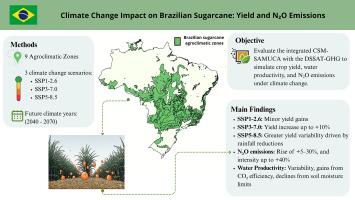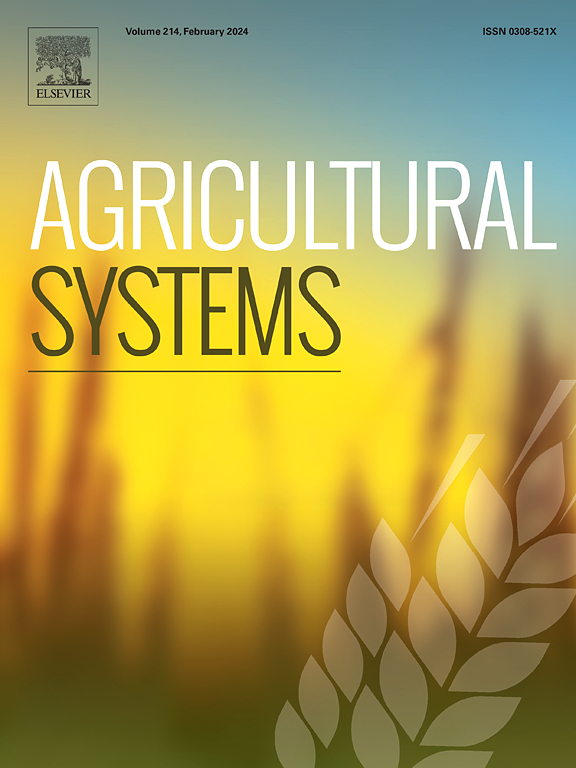利用cms - samuca -甘蔗模型评估气候变化对巴西生物能源甘蔗产量、作物水分生产力和一氧化二氮排放的影响
IF 6.1
1区 农林科学
Q1 AGRICULTURE, MULTIDISCIPLINARY
引用次数: 0
摘要
基于甘蔗的生物能源系统对巴西的可再生能源部门至关重要,对全球减少对化石燃料依赖的努力做出了重大贡献。然而,气候变化带来了与甘蔗产量、水资源利用效率和温室气体排放相关的不确定性。大气中二氧化碳(CO2)水平上升、气温升高以及降水模式的变化预计将影响巴西的生物能源种植区,因此有必要对其对甘蔗生产和环境可持续性的影响进行全面评估。本研究评估了未来气候情景下巴西生物能源种植区二氧化碳升高、气温升高和降水变化对甘蔗产量、作物水分生产力(WP)和一氧化二氮(N2O)排放的影响。方法将csm - samuca -甘蔗模型与DSSAT-GHG模块相结合,模拟了9个农业气候带的甘蔗系统。未来预测(2040-2070)基于20个CMIP6全球气候模式(GCMs)在3个共享社会经济路径下(SSP1-2.6、SSP3-7.0、SSP5-8.5)。结果与结论sssp1 - 2.6(低排放情景)产量变化不大,但CO₂施肥增加。由于变暖和CO₂效应,SSP3-7.0(中/高排放情景)可能使产量增加10%。然而,SSP5-8.5(最极端变暖)和降雨量减少增加了产量变异性。由于土壤变暖和残留物分解速度加快,N₂O排放量可能增加5 - 30%,强度最高可增加40%。WP响应各不相同:一些地区从CO₂诱导的效率中获得,其他地区由于土壤湿度限制而下降。在气候变化下平衡产量提高与N2O缓解仍然是一个挑战。适应气候变化的氮和残留物管理战略对于确保巴西的可持续生物能源生产至关重要。本文章由计算机程序翻译,如有差异,请以英文原文为准。

Assessing climate change impacts on sugarcane yield, crop water productivity, and nitrous oxide emissions across Brazil's bioenergy using the CSM-SAMUCA-sugarcane model
Context
Sugarcane-based bioenergy systems are critical in Brazil's renewable energy sector, contributing significantly to global efforts to reduce fossil fuel dependence. However, climate change introduces uncertainties related to sugarcane yield, water use efficiency, and greenhouse gas emissions. Rising atmospheric carbon dioxide (CO2) levels, increasing temperatures, and shifts in precipitation patterns are expected to impact Brazil's bioenergy cultivated areas, necessitating a comprehensive evaluation of their effects on sugarcane production and environmental sustainability.
Objective
This study assessed the effects of rising CO2, temperature increases, and altered precipitation on sugarcane yield, crop water productivity (WP), and nitrous oxide (N2O) emissions across Brazil's bioenergy cultivation areas under future climate scenarios.
Methods
We integrated the CSM-SAMUCA-Sugarcane model with the DSSAT-GHG module to simulate sugarcane systems across nine agroclimatic zones. Future projections (2040–2070) were based on 20 CMIP6 Global Climate Models (GCMs) under three Shared Socioeconomic Pathways (SSP1–2.6, SSP3–7.0, SSP5–8.5).
Results and conclusions
SSP1–2.6 (low-emission scenario) showed minor yield changes, with some CO₂ fertilization gains. SSP3–7.0 (intermediate/high-emission scenario) may increase yield by up to 10 % due to warming and CO₂ effects. However, SSP5–8.5 (most extreme warming) and rainfall reductions increased yield variability. N₂O emissions may rise by 5–30 %, with intensities up to 40 % higher, driven by warmer soils and faster residue decomposition. WP responses varied: some regions gained from CO₂-induced efficiency, others declined due to soil moisture limits.
Significance
Balancing yield improvements with N2O mitigation under climate change remains a challenge. Climate-resilient nitrogen and residue management strategies are essential to ensure sustainable bioenergy production in Brazil.
求助全文
通过发布文献求助,成功后即可免费获取论文全文。
去求助
来源期刊

Agricultural Systems
农林科学-农业综合
CiteScore
13.30
自引率
7.60%
发文量
174
审稿时长
30 days
期刊介绍:
Agricultural Systems is an international journal that deals with interactions - among the components of agricultural systems, among hierarchical levels of agricultural systems, between agricultural and other land use systems, and between agricultural systems and their natural, social and economic environments.
The scope includes the development and application of systems analysis methodologies in the following areas:
Systems approaches in the sustainable intensification of agriculture; pathways for sustainable intensification; crop-livestock integration; farm-level resource allocation; quantification of benefits and trade-offs at farm to landscape levels; integrative, participatory and dynamic modelling approaches for qualitative and quantitative assessments of agricultural systems and decision making;
The interactions between agricultural and non-agricultural landscapes; the multiple services of agricultural systems; food security and the environment;
Global change and adaptation science; transformational adaptations as driven by changes in climate, policy, values and attitudes influencing the design of farming systems;
Development and application of farming systems design tools and methods for impact, scenario and case study analysis; managing the complexities of dynamic agricultural systems; innovation systems and multi stakeholder arrangements that support or promote change and (or) inform policy decisions.
 求助内容:
求助内容: 应助结果提醒方式:
应助结果提醒方式:


